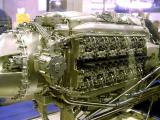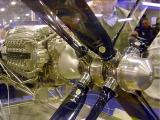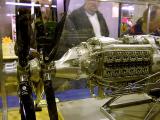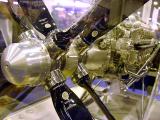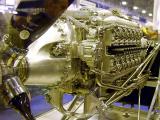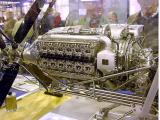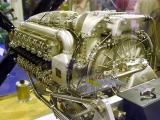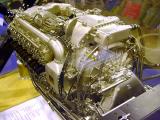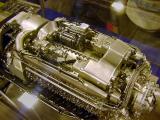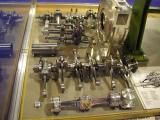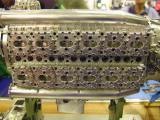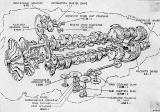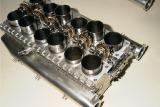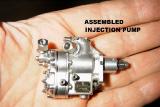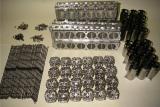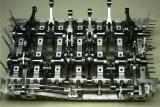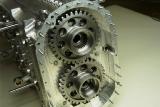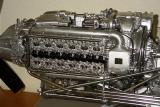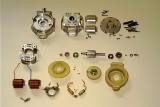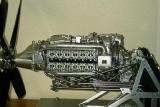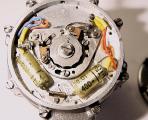by Barrington Hares
Click on a photo to view it full sized.
Now puch your eyeballs back in their sockets, close your mouth, wipe away the dribble, and keep in mind that you are looking through a glass case at a scale model of the Rolls Royce 24 cylinder, sleeve valve, H-configuration Eagle being built by Barrington (Barry) Hares.
Thes pictures were captured by Ken Croft at the 2001 and 2003 Midlands Model Engineeing Exhibition. They show the working model of the Rolls Royce Eagle being built by Barryington Hares. Barry is no newcomer to this (surprise). His running 1/5 scale model of the Rolls Royce Merlin has been astounding people since it first appeared and took the Gold Cup at the 1982 Model Engineering Exhibition. Amazing as that model was in it's attention to detail and accuracy, the Eagle has lifted the bar to unimaginable new heights. One show-goer commented that looking at the model made him feel sick--an unexpected, although understandable reaction.
The Eagle itself is said to represent the pinacle of Rolls Royce piston aero-engine development. In other words, it was the last high-power piston aero engine they developed before moving to gas turbines. Initial development began in 1944. In the search for more power, RR engineers had come to the conclusion that the largest practical bore was about 5 inches, and that sleeve valve technology was superior to the poppet valve, especially in regards to reliability, and time between overhaul (TBO). Accordingly, high power engines would need lots of small cylinders driving multiple crankshafts (engineers on the other side of the pond came to the same conclusion--see the Wright Tornado for this concept carried to the limit).
Having run out of birds of prey engine names, RR re-cycled one of their first aero engine names for the Eagle I of 1944. This led to the Eagle II, then the Eagle 22 of 1947-49. This engine, down-rated, and fitted with the contra rotating airscrew gearbox was installed in the Westland Wyverne I carrier-based attack and torpedo bomber aircraft. The Air Ministary's emerging preference for gas turbines then ran over the project, marking the Eagle 22 as RR's final, high-performance, reciprocating powerplant.
As wonderful as it was to see the Eagle through the glass case, I was delighted to receive an email from Barry who provided the pictures and words below. I also want to congratulate Barry on his modesty. True masters of their craft generally tend towards understatement, and he is certainly no exception. Take for example, the starting system. The Eagle 22 was to have used a Coffman starter. This type of starter had been fitted to the Napier Sabre (also a 24 cylinder sleeve valve H engine) that powered the Hawker Typhoon tank buster, and was later fitted to early British jet engines. For example, that bullet shaped protrusion in the center of the English Electric Canberra jet bomber intakes housed the Coffman cartriges that spun the turbine up to light-off speed with a *crack* and venting of much black smoke vertically up and down that I recall from time in the RAAF Reserve. That Barry has replicated this to a working version using .22 cal cartriges is outstanding--even if it lacks the torque (currently) to spin the monster. Anyway, with no more introcuction, here's Barry's photos followed by his words:
Ron,
Here are some shots of the current project, the Rolls-Royce Eagle 22. This is again 1/5th size and finishes up at 360cc. It is an H engine similar to the Sabre, but somewhat larger. I have now almost completed it, the remaining major work being to set up the fuel injection, and prop internals. I then have to pluck up the guts to try starting the brute.
Yes, it was fitted with an unusual version of the Coffman, a 6 cartridge electrically indexed and fired type L44S. I had hoped to make this work, but although the starter is working ( it is chambered for long rifle .22 cartridges) the stresses on the coupling gears etc are far too high.
I set up the engine without plugs and motored it over using a 3/4 hp motor
to run in the oil system etc. There is so much friction that the motor
burnt out, so no chance for the Coffman. The magnetos are each, dual 12
cylinder units ie 24 sparks per rev. On the photo of the contact breaker
the main ring is 1.5" dia. The full size had problems with the reliability
of the sleeve drive, so we shall see what happens with the model.
The main details are:-
Type. Geared, pressure liquid cooled flat H sleeve valve engine with two
speed two stage liquid cooled supercharger, driving
contra-rotating propellers through reduction gearing.
Best wishes,
Barry Hares.
This page designed to look best when using anything but IE!
Please submit all questions and comments to
[email protected]
Full Size Model Bore 5.4 in 1.08 in
Stroke 5.125 in 1.025 in
Volume 2816 cuin (46 litres) 22.5 cuin (386cc)
Compression ratio 6.5:1 6.5:1
Super charger ratios 3:1 and 3.67:1 3:1 and 3.67:1
Reduction gear ratio .298:1 .387:1
Carburation Indirect fuel injection into first stage impeller. (per full size)
![]()
